JEEP GRAND CHEROKEE 2012 Owner handbook (in English)
Manufacturer: JEEP, Model Year: 2012, Model line: GRAND CHEROKEE, Model: JEEP GRAND CHEROKEE 2012Pages: 380, PDF Size: 3.21 MB
Page 51 of 380
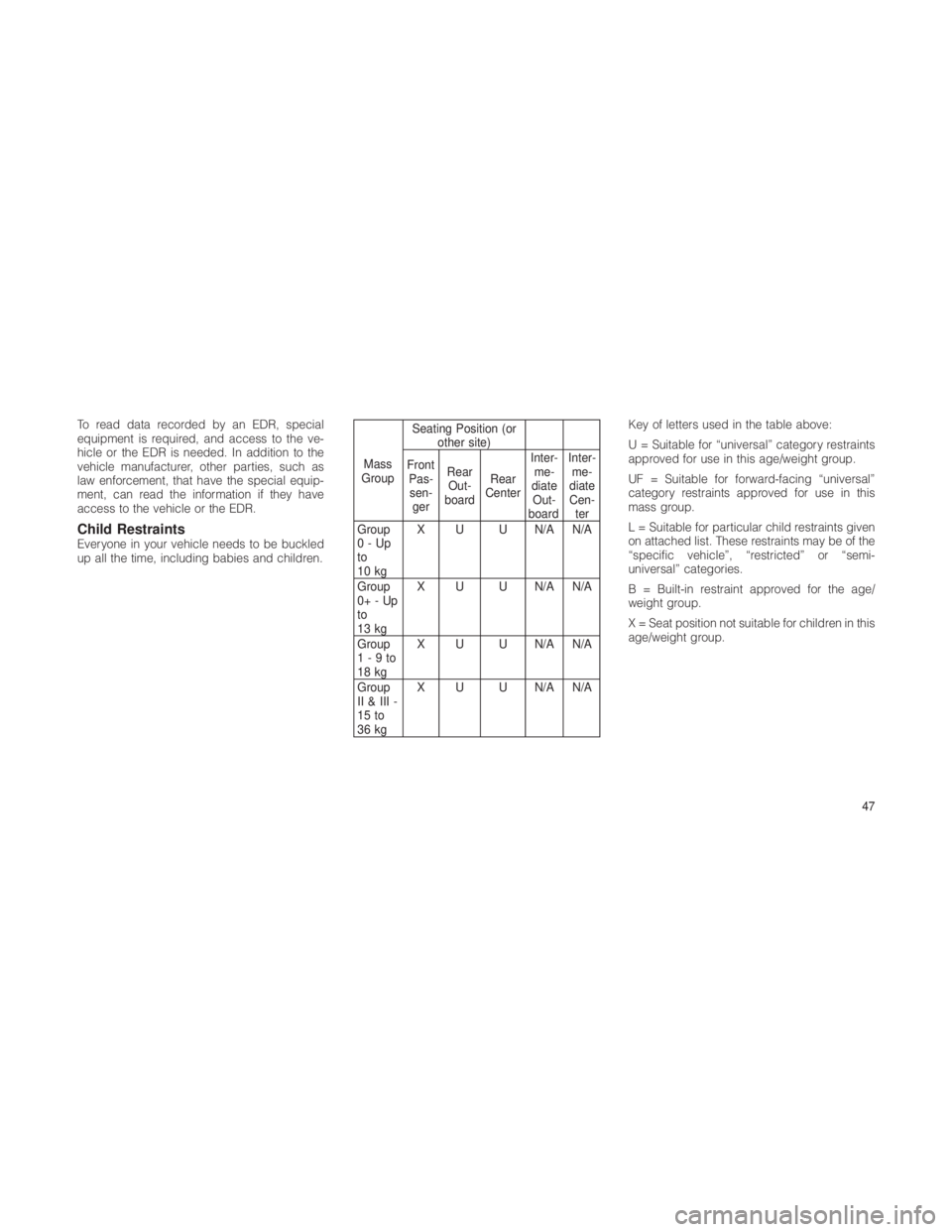
To read data recorded by an EDR, special
equipment is required, and access to the ve-
hicle or the EDR is needed. In addition to the
vehicle manufacturer, other parties, such as
law enforcement, that have the special equip-
ment, can read the information if they have
access to the vehicle or the EDR.
Child RestraintsEveryone in your vehicle needs to be buckled
up all the time, including babies and children.
Mass
Group Seating Position (or
other site)
Front Pas-sen- ger Rear
Out-
board Rear
Center Inter-
me-
diate Out-
board Inter-
me-
diate
Cen- ter
Group
0-Up
to
10 kg X U U N/A N/A
Group
0+-Up
to
13 kg X U U N/A N/A
Group
1-9to
18 kg X U U N/A N/A
Group
II & III -
15 to
36 kg X U U N/A N/A Key of letters used in the table above:
U = Suitable for “universal” category restraints
approved for use in this age/weight group.
UF = Suitable for forward-facing “universal”
category restraints approved for use in this
mass group.
L = Suitable for particular child restraints given
on attached list. These restraints may be of the
“specific vehicle”, “restricted” or “semi-
universal” categories.
B = Built-in restraint approved for the age/
weight group.
X = Seat position not suitable for children in this
age/weight group.
47
Page 52 of 380
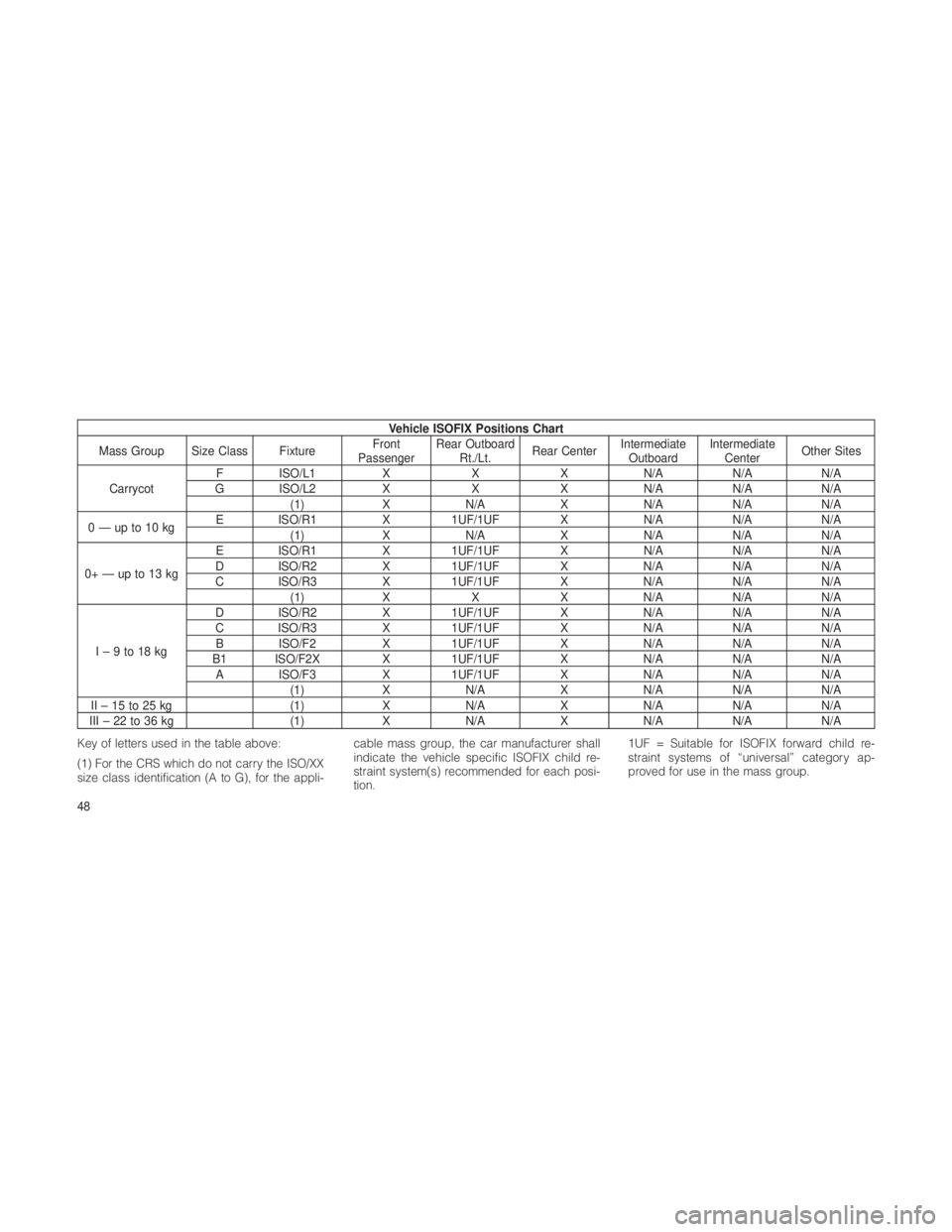
Vehicle ISOFIX Positions Chart
Mass Group Size Class Fixture Front
Passenger Rear Outboard
Rt./Lt. Rear Center Intermediate
Outboard Intermediate
Center Other Sites
Carrycot F ISO/L1
XXXN/A N/AN/A
G ISO/L2 XXXN/A N/AN/A
(1) XN/A XN/A N/AN/A
0—upto10kg E ISO/R1
X1UF/1UF XN/A N/AN/A
(1) XN/A XN/A N/AN/A
0+—upto13kg E ISO/R1
X1UF/1UF XN/A N/AN/A
D ISO/R2 X1UF/1UF XN/A N/AN/A
C ISO/R3 X1UF/1UF XN/A N/AN/A
(1) XXXN/A N/AN/A
I–9to18kg D ISO/R2
X1UF/1UF XN/A N/AN/A
C ISO/R3 X1UF/1UF XN/A N/AN/A
B ISO/F2 X1UF/1UF XN/A N/AN/A
B1 ISO/F2X X1UF/1UF XN/A N/AN/A
A ISO/F3 X1UF/1UF XN/A N/AN/A
(1) XN/A XN/A N/AN/A
II – 15 to 25 kg (1)XN/A XN/A N/AN/A
III – 22 to 36 kg (1)XN/A XN/A N/AN/A
Key of letters used in the table above:
(1) For the CRS which do not carry the ISO/XX
size class identification (A to G), for the appli- cable mass group, the car manufacturer shall
indicate the vehicle specific ISOFIX child re-
straint system(s) recommended for each posi-
tion.1UF = Suitable for ISOFIX forward child re-
straint systems of “universal” category ap-
proved for use in the mass group.
48
Page 53 of 380
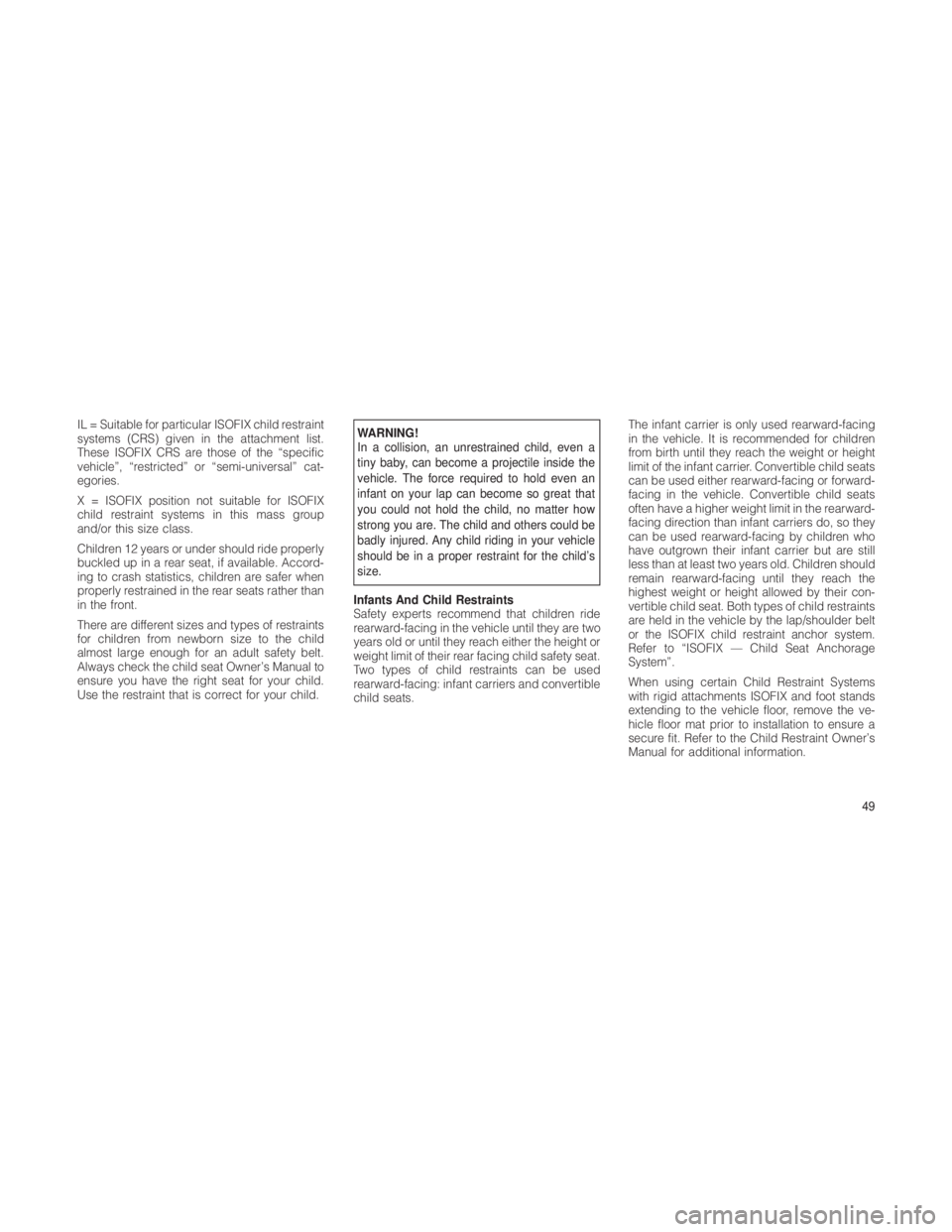
IL = Suitable for particular ISOFIX child restraint
systems (CRS) given in the attachment list.
These ISOFIX CRS are those of the “specific
vehicle”, “restricted” or “semi-universal” cat-
egories.
X = ISOFIX position not suitable for ISOFIX
child restraint systems in this mass group
and/or this size class.
Children 12 years or under should ride properly
buckled up in a rear seat, if available. Accord-
ing to crash statistics, children are safer when
properly restrained in the rear seats rather than
in the front.
There are different sizes and types of restraints
for children from newborn size to the child
almost large enough for an adult safety belt.
Always check the child seat Owner’s Manual to
ensure you have the right seat for your child.
Use the restraint that is correct for your child.WARNING!
In a collision, an unrestrained child, even a
tiny baby, can become a projectile inside the
vehicle. The force required to hold even an
infant on your lap can become so great that
you could not hold the child, no matter how
strong you are. The child and others could be
badly injured. Any child riding in your vehicle
should be in a proper restraint for the child’s
size.
Infants And Child Restraints
Safety experts recommend that children ride
rearward-facing in the vehicle until they are two
years old or until they reach either the height or
weight limit of their rear facing child safety seat.
Two types of child restraints can be used
rearward-facing: infant carriers and convertible
child seats. The infant carrier is only used rearward-facing
in the vehicle. It is recommended for children
from birth until they reach the weight or height
limit of the infant carrier. Convertible child seats
can be used either rearward-facing or forward-
facing in the vehicle. Convertible child seats
often have a higher weight limit in the rearward-
facing direction than infant carriers do, so they
can be used rearward-facing by children who
have outgrown their infant carrier but are still
less than at least two years old. Children should
remain rearward-facing until they reach the
highest weight or height allowed by their con-
vertible child seat. Both types of child restraints
are held in the vehicle by the lap/shoulder belt
or the ISOFIX child restraint anchor system.
Refer to “ISOFIX — Child Seat Anchorage
System”.
When using certain Child Restraint Systems
with rigid attachments ISOFIX and foot stands
extending to the vehicle floor, remove the ve-
hicle floor mat prior to installation to ensure a
secure fit. Refer to the Child Restraint Owner’s
Manual for additional information.
49
Page 54 of 380
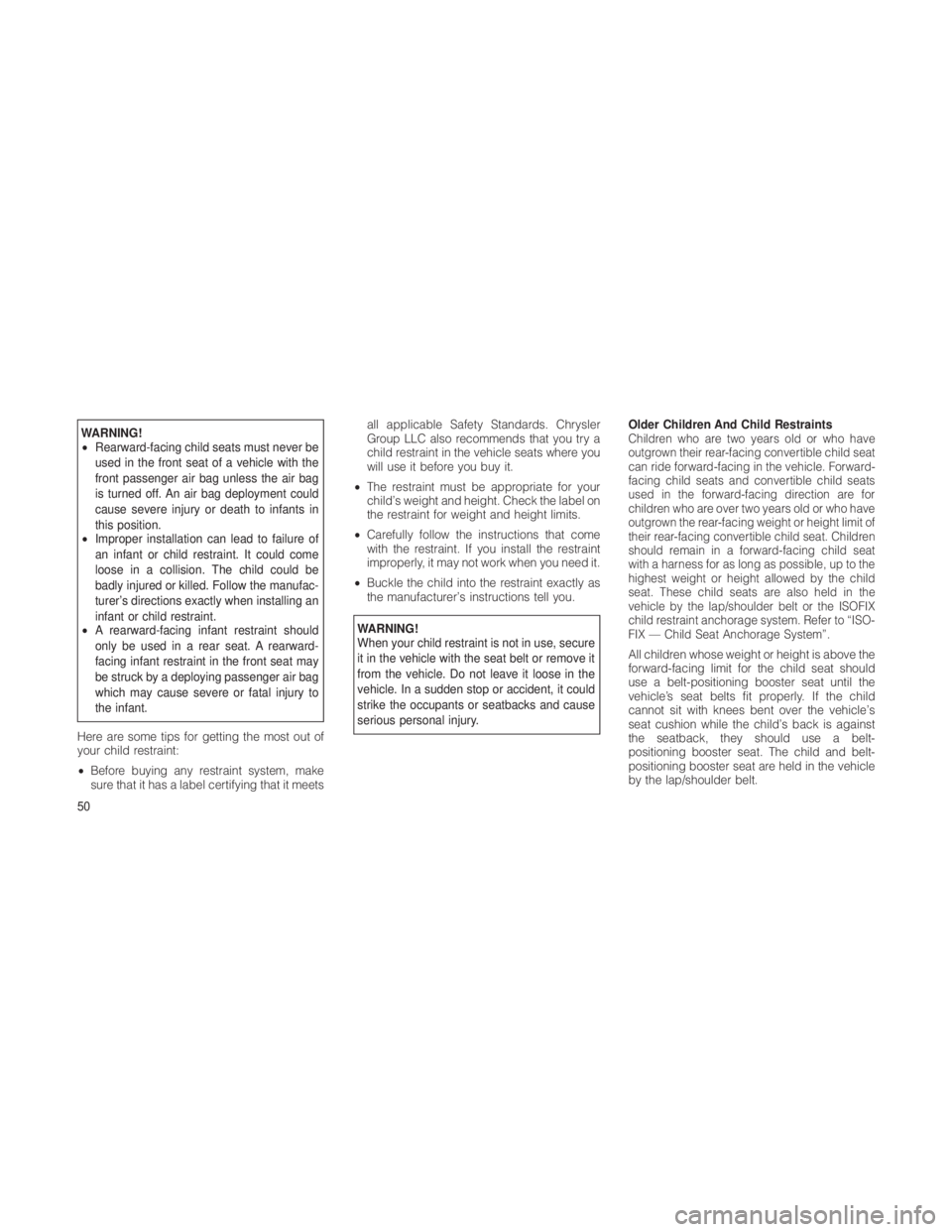
WARNING!
•Rearward-facing child seats must never be
used in the front seat of a vehicle with the
front passenger air bag unless the air bag
is turned off. An air bag deployment could
cause severe injury or death to infants in
this position.
• Improper installation can lead to failure of
an infant or child restraint. It could come
loose in a collision. The child could be
badly injured or killed. Follow the manufac-
turer’s directions exactly when installing an
infant or child restraint.
• A rearward-facing infant restraint should
only be used in a rear seat. A rearward-
facing infant restraint in the front seat may
be struck by a deploying passenger air bag
which may cause severe or fatal injury to
the infant.
Here are some tips for getting the most out of
your child restraint:
• Before buying any restraint system, make
sure that it has a label certifying that it meets all applicable Safety Standards. Chrysler
Group LLC also recommends that you try a
child restraint in the vehicle seats where you
will use it before you buy it.
• The restraint must be appropriate for your
child’s weight and height. Check the label on
the restraint for weight and height limits.
• Carefully follow the instructions that come
with the restraint. If you install the restraint
improperly, it may not work when you need it.
• Buckle the child into the restraint exactly as
the manufacturer’s instructions tell you.
WARNING!
When your child restraint is not in use, secure
it in the vehicle with the seat belt or remove it
from the vehicle. Do not leave it loose in the
vehicle. In a sudden stop or accident, it could
strike the occupants or seatbacks and cause
serious personal injury. Older Children And Child Restraints
Children who are two years old or who have
outgrown their rear-facing convertible child seat
can ride forward-facing in the vehicle. Forward-
facing child seats and convertible child seats
used in the forward-facing direction are for
children who are over two years old or who have
outgrown the rear-facing weight or height limit of
their rear-facing convertible child seat. Children
should remain in a forward-facing child seat
with a harness for as long as possible, up to the
highest weight or height allowed by the child
seat. These child seats are also held in the
vehicle by the lap/shoulder belt or the ISOFIX
child restraint anchorage system. Refer to “ISO-
FIX — Child Seat Anchorage System”.
All children whose weight or height is above the
forward-facing limit for the child seat should
use a belt-positioning booster seat until the
vehicle’s seat belts fit properly. If the child
cannot sit with knees bent over the vehicle’s
seat cushion while the child’s back is against
the seatback, they should use a belt-
positioning booster seat. The child and belt-
positioning booster seat are held in the vehicle
by the lap/shoulder belt.
50
Page 55 of 380
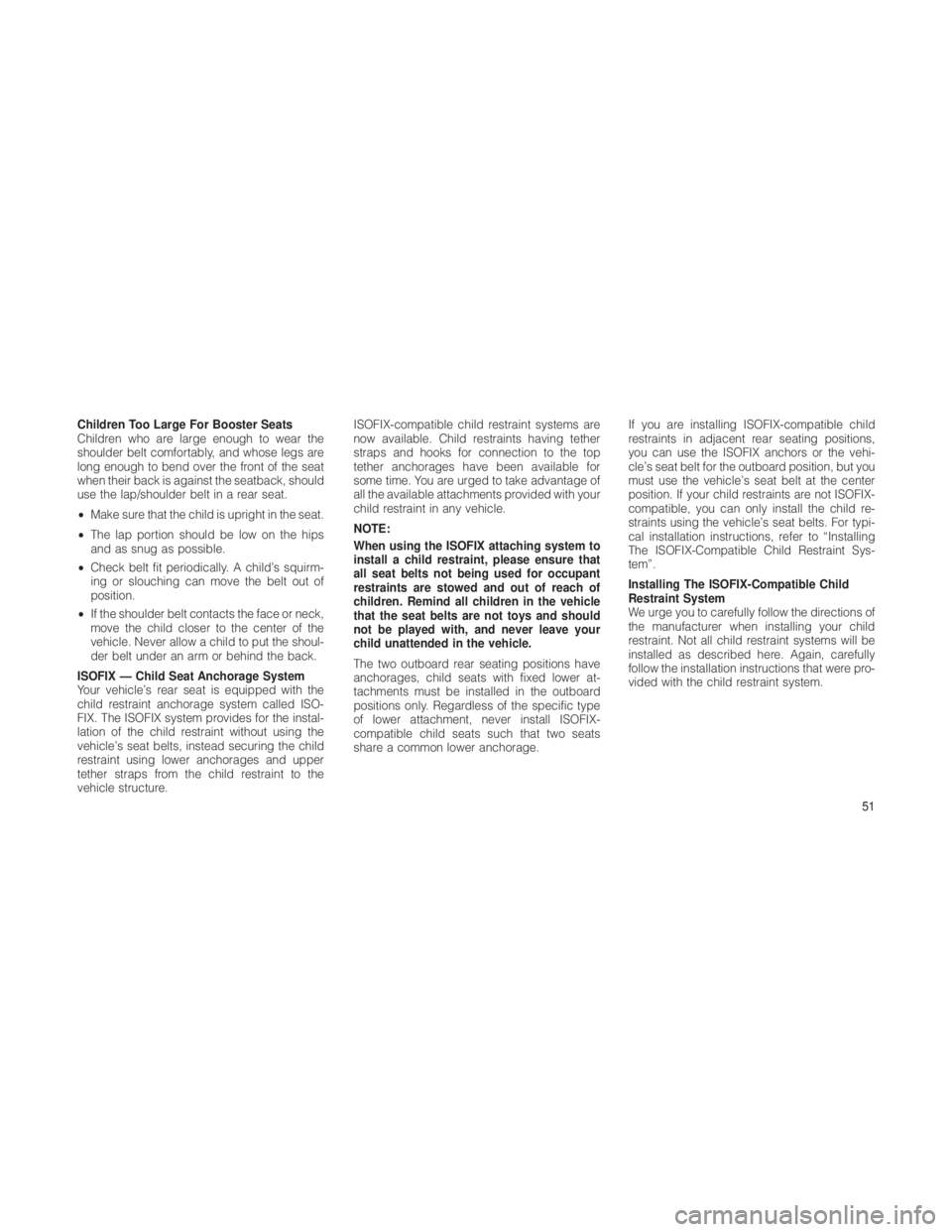
Children Too Large For Booster Seats
Children who are large enough to wear the
shoulder belt comfortably, and whose legs are
long enough to bend over the front of the seat
when their back is against the seatback, should
use the lap/shoulder belt in a rear seat.
•Make sure that the child is upright in the seat.
• The lap portion should be low on the hips
and as snug as possible.
• Check belt fit periodically. A child’s squirm-
ing or slouching can move the belt out of
position.
• If the shoulder belt contacts the face or neck,
move the child closer to the center of the
vehicle. Never allow a child to put the shoul-
der belt under an arm or behind the back.
ISOFIX — Child Seat Anchorage System
Your vehicle’s rear seat is equipped with the
child restraint anchorage system called ISO-
FIX. The ISOFIX system provides for the instal-
lation of the child restraint without using the
vehicle’s seat belts, instead securing the child
restraint using lower anchorages and upper
tether straps from the child restraint to the
vehicle structure. ISOFIX-compatible child restraint systems are
now available. Child restraints having tether
straps and hooks for connection to the top
tether anchorages have been available for
some time. You are urged to take advantage of
all the available attachments provided with your
child restraint in any vehicle.
NOTE:
When using the ISOFIX attaching system to
install a child restraint, please ensure that
all seat belts not being used for occupant
restraints are stowed and out of reach of
children. Remind all children in the vehicle
that the seat belts are not toys and should
not be played with, and never leave your
child unattended in the vehicle.
The two outboard rear seating positions have
anchorages, child seats with fixed lower at-
tachments must be installed in the outboard
positions only. Regardless of the specific type
of lower attachment, never install ISOFIX-
compatible child seats such that two seats
share a common lower anchorage.
If you are installing ISOFIX-compatible child
restraints in adjacent rear seating positions,
you can use the ISOFIX anchors or the vehi-
cle’s seat belt for the outboard position, but you
must use the vehicle’s seat belt at the center
position. If your child restraints are not ISOFIX-
compatible, you can only install the child re-
straints using the vehicle’s seat belts. For typi-
cal installation instructions, refer to “Installing
The ISOFIX-Compatible Child Restraint Sys-
tem”.
Installing The ISOFIX-Compatible Child
Restraint System
We urge you to carefully follow the directions of
the manufacturer when installing your child
restraint. Not all child restraint systems will be
installed as described here. Again, carefully
follow the installation instructions that were pro-
vided with the child restraint system.
51
Page 56 of 380

The rear seat lower anchorages are round bars,
located at the rear of the seat cushion where it
meets the seatback, and are just visible when
you lean into the rear seat to install the child
restraint. You will easily feel them if you run your
finger along the intersection of the seatback
and seat cushion surfaces.
In addition, there are top tether strap anchor-
ages behind each rear seating position located
on the back of the outboard seats. To access
the top tether strap anchorages behind the rear
seat, pull the carpeted floor panel away from
the seat back, this will expose the top tether
strap anchorages.WARNING!
Do not use the cargo tie downs located on the
load floor. Improper usage of the tether can
lead to a failure of an infant or child restraint.
The child could be badly injured or killed.
Many, but not all, restraint systems will be
equipped with separate straps on each side,
with each having a hook or connector for
attachment to the lower anchorage and a
means of adjusting the tension in the strap.
Forward-facing toddler restraints and some
rear-facing infant restraints will also be
equipped with a tether strap, a hook for attach-
ment to the tether strap anchorage and a
means of adjusting the tension of the strap.
First, loosen the child seat adjusters on the
lower straps and on the tether strap so that you
can more easily attach the hooks or connectors
to the vehicle anchorages. Next, attach the
lower hooks or connectors over the top of the
anchorage bars, pushing aside the seat cover
material. Then, locate the tether anchorage
directly behind the seat where you are placing
the child restraint and attach the tether strap to
ISOFIX Anchorages
Pulling Down The Carpet Floor Panel To Access Top Tether Strap
Top Tether Strap Anchorage(Located on Seatback)
52
Page 57 of 380
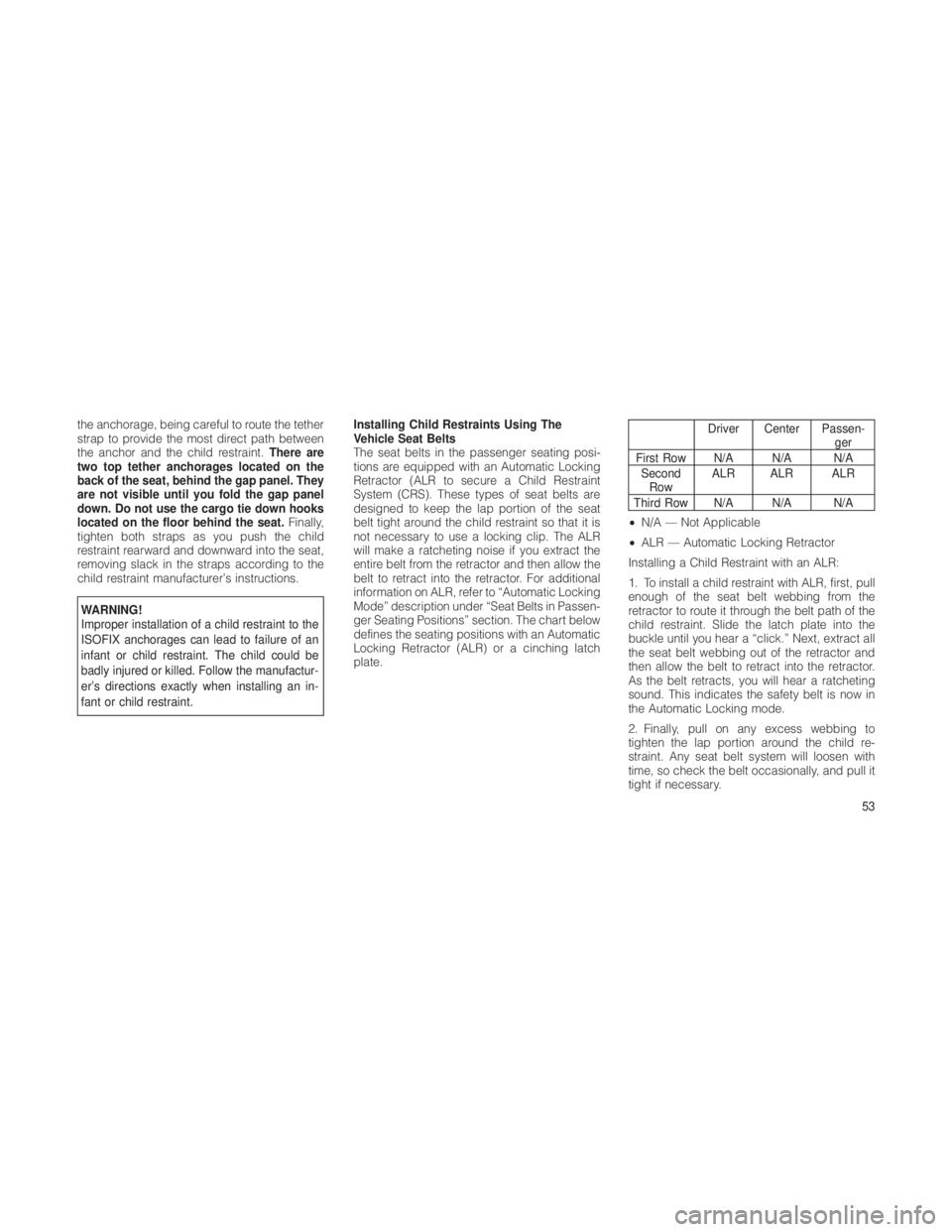
the anchorage, being careful to route the tether
strap to provide the most direct path between
the anchor and the child restraint.There are
two top tether anchorages located on the
back of the seat, behind the gap panel. They
are not visible until you fold the gap panel
down. Do not use the cargo tie down hooks
located on the floor behind the seat. Finally,
tighten both straps as you push the child
restraint rearward and downward into the seat,
removing slack in the straps according to the
child restraint manufacturer’s instructions.
WARNING!
Improper installation of a child restraint to the
ISOFIX anchorages can lead to failure of an
infant or child restraint. The child could be
badly injured or killed. Follow the manufactur-
er’s directions exactly when installing an in-
fant or child restraint. Installing Child Restraints Using The
Vehicle Seat Belts
The seat belts in the passenger seating posi-
tions are equipped with an Automatic Locking
Retractor (ALR to secure a Child Restraint
System (CRS). These types of seat belts are
designed to keep the lap portion of the seat
belt tight around the child restraint so that it is
not necessary to use a locking clip. The ALR
will make a ratcheting noise if you extract the
entire belt from the retractor and then allow the
belt to retract into the retractor. For additional
information on ALR, refer to “Automatic Locking
Mode” description under “Seat Belts in Passen-
ger Seating Positions” section. The chart below
defines the seating positions with an Automatic
Locking Retractor (ALR) or a cinching latch
plate.
Driver Center Passen-
ger
First Row N/A N/A N/A Second Row ALR ALR ALR
Third Row N/A N/A N/A
• N/A — Not Applicable
• ALR — Automatic Locking Retractor
Installing a Child Restraint with an ALR:
1. To install a child restraint with ALR, first, pull
enough of the seat belt webbing from the
retractor to route it through the belt path of the
child restraint. Slide the latch plate into the
buckle until you hear a “click.” Next, extract all
the seat belt webbing out of the retractor and
then allow the belt to retract into the retractor.
As the belt retracts, you will hear a ratcheting
sound. This indicates the safety belt is now in
the Automatic Locking mode.
2. Finally, pull on any excess webbing to
tighten the lap portion around the child re-
straint. Any seat belt system will loosen with
time, so check the belt occasionally, and pull it
tight if necessary.
53
Page 58 of 380
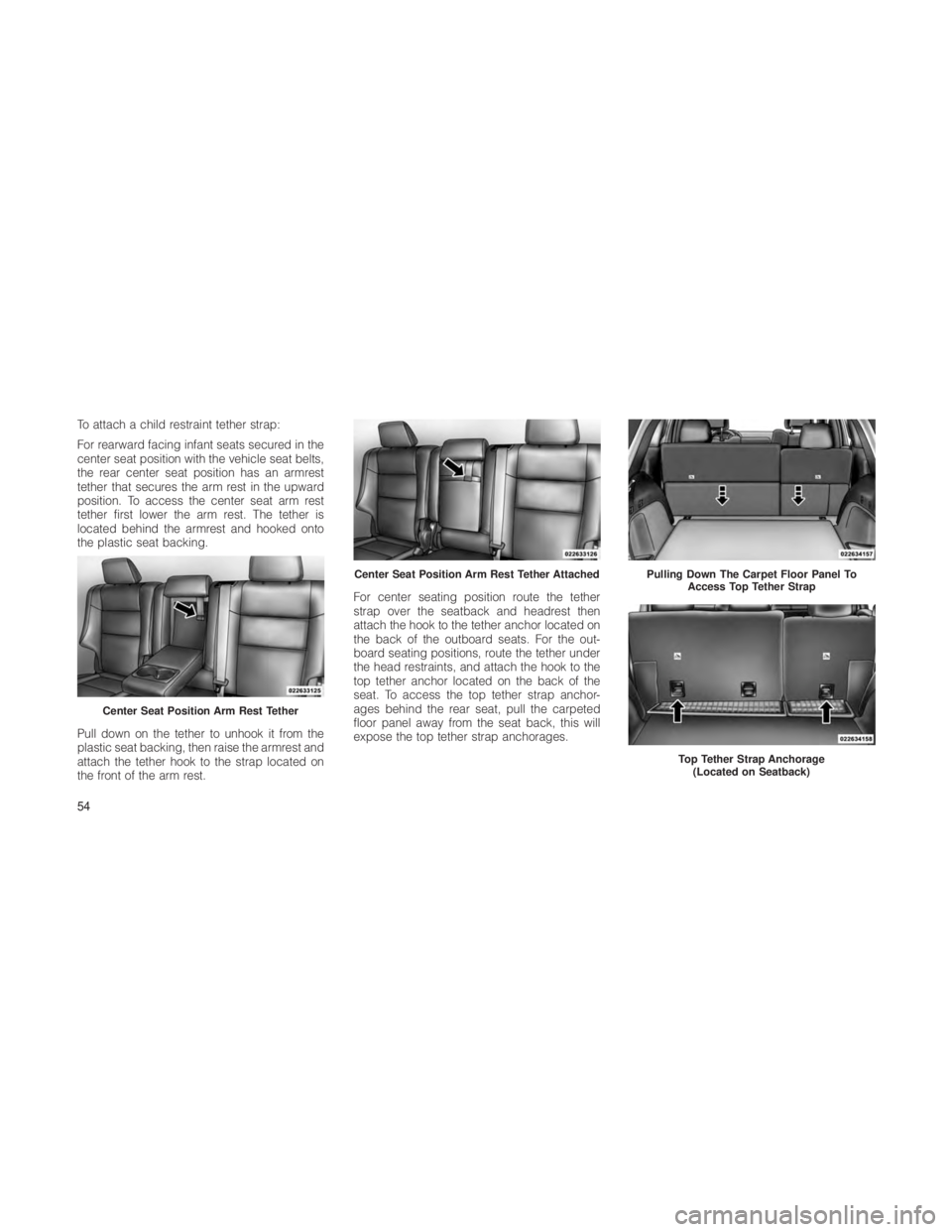
To attach a child restraint tether strap:
For rearward facing infant seats secured in the
center seat position with the vehicle seat belts,
the rear center seat position has an armrest
tether that secures the arm rest in the upward
position. To access the center seat arm rest
tether first lower the arm rest. The tether is
located behind the armrest and hooked onto
the plastic seat backing.
Pull down on the tether to unhook it from the
plastic seat backing, then raise the armrest and
attach the tether hook to the strap located on
the front of the arm rest.For center seating position route the tether
strap over the seatback and headrest then
attach the hook to the tether anchor located on
the back of the outboard seats. For the out-
board seating positions, route the tether under
the head restraints, and attach the hook to the
top tether anchor located on the back of the
seat. To access the top tether strap anchor-
ages behind the rear seat, pull the carpeted
floor panel away from the seat back, this will
expose the top tether strap anchorages.
Center Seat Position Arm Rest Tether
Center Seat Position Arm Rest Tether AttachedPulling Down The Carpet Floor Panel To
Access Top Tether Strap
Top Tether Strap Anchorage(Located on Seatback)
54
Page 59 of 380
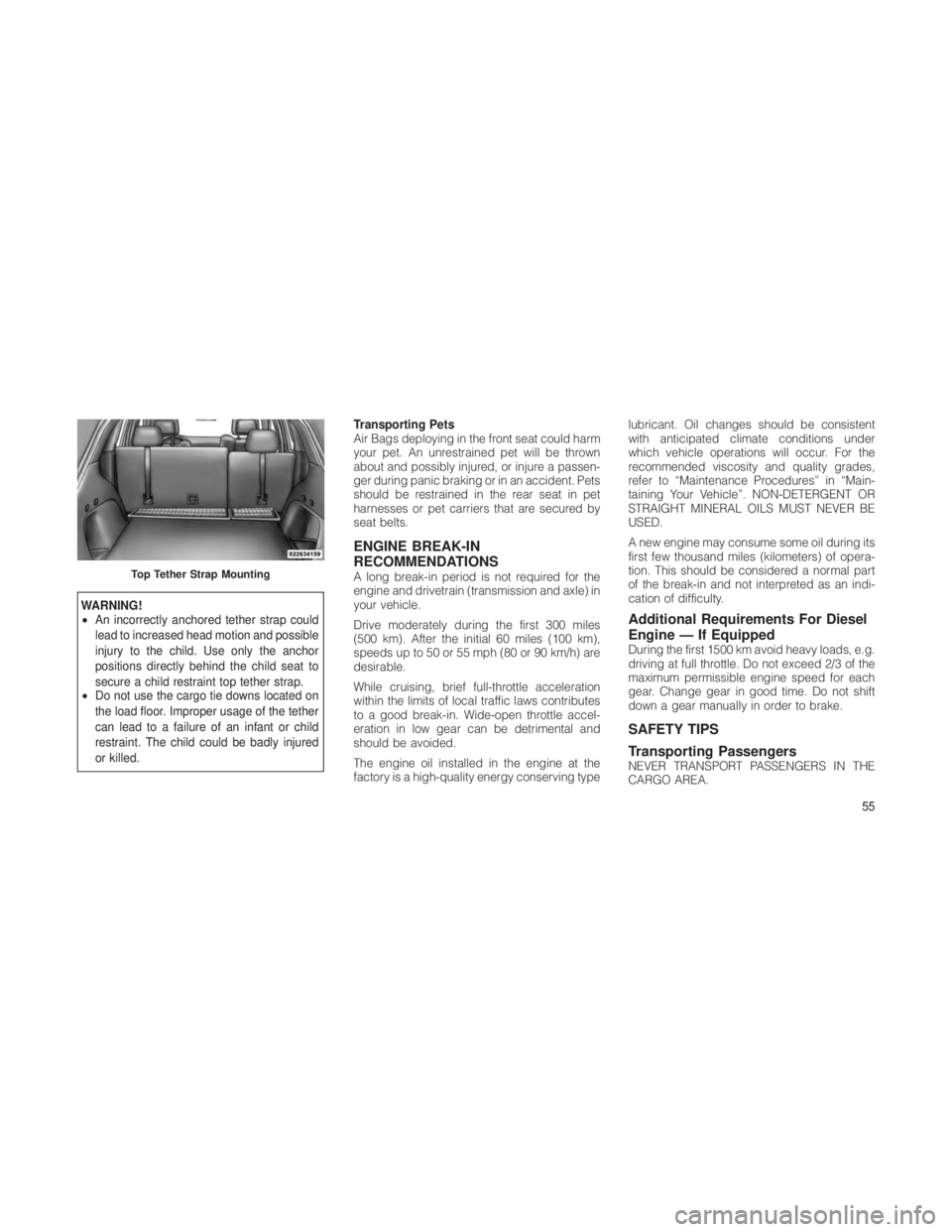
WARNING!
•An incorrectly anchored tether strap could
lead to increased head motion and possible
injury to the child. Use only the anchor
positions directly behind the child seat to
secure a child restraint top tether strap.
• Do not use the cargo tie downs located on
the load floor. Improper usage of the tether
can lead to a failure of an infant or child
restraint. The child could be badly injured
or killed. Transporting Pets
Air Bags deploying in the front seat could harm
your pet. An unrestrained pet will be thrown
about and possibly injured, or injure a passen-
ger during panic braking or in an accident. Pets
should be restrained in the rear seat in pet
harnesses or pet carriers that are secured by
seat belts.
ENGINE BREAK-IN
RECOMMENDATIONS
A long break-in period is not required for the
engine and drivetrain (transmission and axle) in
your vehicle.
Drive moderately during the first 300 miles
(500 km). After the initial 60 miles (100 km),
speeds up to 50 or 55 mph (80 or 90 km/h) are
desirable.
While cruising, brief full-throttle acceleration
within the limits of local traffic laws contributes
to a good break-in. Wide-open throttle accel-
eration in low gear can be detrimental and
should be avoided.
The engine oil installed in the engine at the
factory is a high-quality energy conserving type lubricant. Oil changes should be consistent
with anticipated climate conditions under
which vehicle operations will occur. For the
recommended viscosity and quality grades,
refer to “Maintenance Procedures” in “Main-
taining Your Vehicle”. NON-DETERGENT OR
STRAIGHT MINERAL OILS MUST NEVER BE
USED.
A new engine may consume some oil during its
first few thousand miles (kilometers) of opera-
tion. This should be considered a normal part
of the break-in and not interpreted as an indi-
cation of difficulty.
Additional Requirements For Diesel
Engine — If Equipped
During the first 1500 km avoid heavy loads, e.g.
driving at full throttle. Do not exceed 2/3 of the
maximum permissible engine speed for each
gear. Change gear in good time. Do not shift
down a gear manually in order to brake.
SAFETY TIPS
Transporting Passengers
NEVER TRANSPORT PASSENGERS IN THE
CARGO AREA.
Top Tether Strap Mounting
55
Page 60 of 380
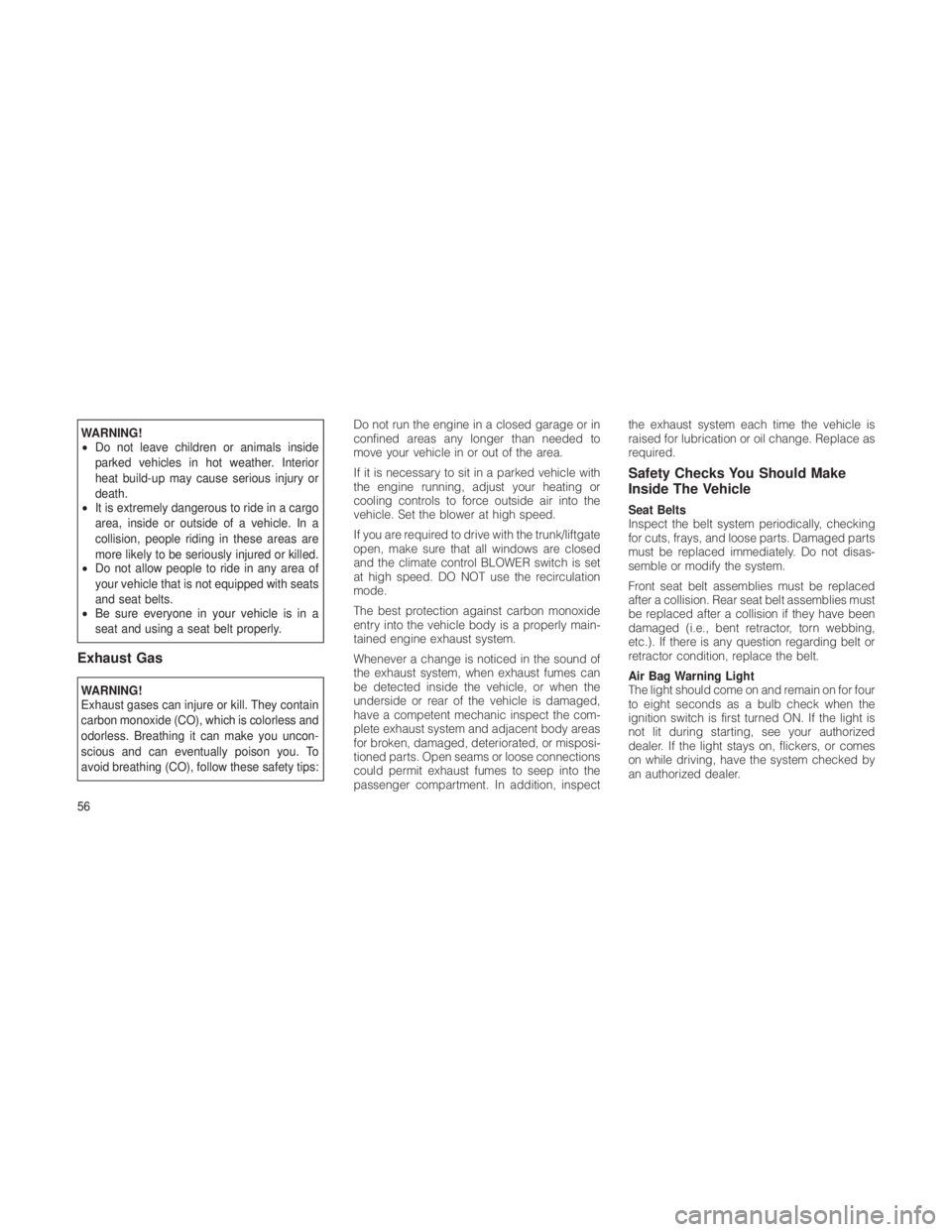
WARNING!
•Do not leave children or animals inside
parked vehicles in hot weather. Interior
heat build-up may cause serious injury or
death.
• It is extremely dangerous to ride in a cargo
area, inside or outside of a vehicle. In a
collision, people riding in these areas are
more likely to be seriously injured or killed.
• Do not allow people to ride in any area of
your vehicle that is not equipped with seats
and seat belts.
• Be sure everyone in your vehicle is in a
seat and using a seat belt properly.
Exhaust Gas
WARNING!
Exhaust gases can injure or kill. They contain
carbon monoxide (CO), which is colorless and
odorless. Breathing it can make you uncon-
scious and can eventually poison you. To
avoid breathing (CO), follow these safety tips: Do not run the engine in a closed garage or in
confined areas any longer than needed to
move your vehicle in or out of the area.
If it is necessary to sit in a parked vehicle with
the engine running, adjust your heating or
cooling controls to force outside air into the
vehicle. Set the blower at high speed.
If you are required to drive with the trunk/liftgate
open, make sure that all windows are closed
and the climate control BLOWER switch is set
at high speed. DO NOT use the recirculation
mode.
The best protection against carbon monoxide
entry into the vehicle body is a properly main-
tained engine exhaust system.
Whenever a change is noticed in the sound of
the exhaust system, when exhaust fumes can
be detected inside the vehicle, or when the
underside or rear of the vehicle is damaged,
have a competent mechanic inspect the com-
plete exhaust system and adjacent body areas
for broken, damaged, deteriorated, or misposi-
tioned parts. Open seams or loose connections
could permit exhaust fumes to seep into the
passenger compartment. In addition, inspect the exhaust system each time the vehicle is
raised for lubrication or oil change. Replace as
required.
Safety Checks You Should Make
Inside The Vehicle
Seat Belts
Inspect the belt system periodically, checking
for cuts, frays, and loose parts. Damaged parts
must be replaced immediately. Do not disas-
semble or modify the system.
Front seat belt assemblies must be replaced
after a collision. Rear seat belt assemblies must
be replaced after a collision if they have been
damaged (i.e., bent retractor, torn webbing,
etc.). If there is any question regarding belt or
retractor condition, replace the belt.
Air Bag Warning Light
The light should come on and remain on for four
to eight seconds as a bulb check when the
ignition switch is first turned ON. If the light is
not lit during starting, see your authorized
dealer. If the light stays on, flickers, or comes
on while driving, have the system checked by
an authorized dealer.
56